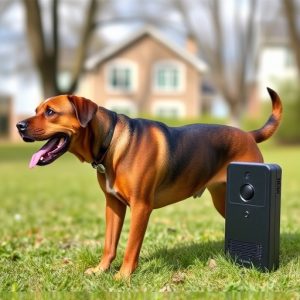Electronic Barking Dog Alarm: An Innovative Deterrent for Property Security
The electronic barking dog alarm represents a cutting-edge advancement in home security, leveraging …….
The electronic barking dog alarm represents a cutting-edge advancement in home security, leveraging the naturally intimidating sounds of a real barking dog to deter intruders. This device simulates these sounds effectively, serving as a virtual guard dog that requires none of the responsibilities or care that a live dog entails. Its installation is beneficial for both residential and commercial properties, offering a discreet yet powerful security measure. The alarm emits a series of realistic barks that are loud enough to be heard across wide areas without causing excessive disruption. It operates on a motion-activated or beam-breaking trigger system, designed to only sound in the presence of actual threats, thus minimizing false alarms. For optimal performance, proper installation according to the manufacturer's guidelines and regular maintenance are essential. This includes checking batteries, clearing speakers, adjusting sensor sensitivity, and staying compliant with local noise ordinances. Clear communication with neighbors about the alarm's operation can also help mitigate any potential confusion upon activation. As a non-lethal deterrent system, the electronic barking dog alarm enhances property security by exploiting the psychological impact of perceived guard dog presence.
Exploring the multifaceted role of electronic barking dog sound alarms in deterring unauthorized access, this article delves into their mechanisms, scientific foundations, and practical deployment. From understanding their potential as a security measure to navigating installation and legal aspects, gain insights into how these alarms operate and why they remain a pivotal tool in property protection strategies.
Understanding the Electronic Barking Dog Sound Alarm: A Deterrent Innovation
The electronic barking dog sound alarm represents a significant advancement in home security systems, leveraging the natural deterrent properties of canine vocalizations to protect property and discourage intruders. This innovation mimics the realistic and startling sounds of a real barking dog, a proven method to alert occupants of potential breaches while simultaneously deterring would-be thieves with the simulated auditory cue. The alarm’s design is predicated on the understanding that the presence of a guard dog can significantly enhance security, yet it avoids the logistical challenges of owning and caring for an actual animal.
Installing an electronic barking dog sound alarm is a strategic decision for homeowners and businesses alike, aiming to safeguard their premises without the complexities of maintaining live animals. The device operates on a simple yet effective principle: upon activation, it unleashes a series of convincing simulated barks that are loud enough to be heard clearly across large areas, yet discreet enough not to cause unnecessary disturbance. This dual functionality ensures that the alarm is both a potent deterrent and a non-disruptive security measure for residential and commercial settings.
The Science Behind Electronic Barking Dog Sound Alarms: How They Work and Their Effectiveness
Electronic barking dog sound alarms are designed to simulate the auditory cues associated with a real canine’s warning bark. These devices leverage the natural attentiveness of humans to such sounds, effectively serving as an intruder deterrent. The science behind these alarms lies in the acoustic characteristics that mimic a dog’s natural vocalizations. By emitting a high-pitched, rhythmic barking pattern, the alarm creates a disorienting sound that is unmistakable and often perceived as a genuine threat by an intruder.
The effectiveness of electronic barking dog alarms stems from their ability to trigger a psychological response in potential burglars. Studies have shown that the presence of a security measure that convincingly imitates a guard dog’s alarm can significantly reduce the likelihood of a break-in. The simulated sounds are programmed to activate under specific conditions, such as the detection of motion or the crossing of an invisible beam, ensuring that they respond only to actual threats. This targeted activation minimizes false alarms and maintains the system’s reliability as a security measure in deterring unauthorized access.
Implementing an Electronic Barking Dog Sound Alarm: Installation, Maintenance, and Legal Considerations
When integrating an electronic barking dog sound alarm system, it is imperative to consider the installation process, which should be executed with precision to ensure optimal functionality and effectiveness. This system typically involves placing a small speaker within your property that emits a high-pitched, realistic barking sound upon activation. The installation should adhere to manufacturer guidelines, often requiring minimal tools and expertise. Once installed, regular maintenance checks are necessary to confirm the alarm is operational and the sound intensity meets the required deterrent levels. Maintenance may include battery replacement or recharging for battery-powered units, ensuring speakers are clear of obstructions, and verifying sensor sensitivity.
It is equally important to be cognizant of local regulations concerning the use of electronic security devices. In some jurisdictions, there may be specific bylaws regarding noise levels and the use of audible alarms. Homeowners must ascertain that their use of an electronic barking dog sound alarm complies with these laws to avoid potential legal repercussions. Additionally, it is advisable to notify neighbors of its installation to prevent any misunderstandings should the alarm activate unexpectedly. By adhering to proper installation and maintenance protocols and understanding the legal framework within which these systems operate, users can effectively employ an electronic barking dog sound alarm as a non-lethal intruder deterrent.


